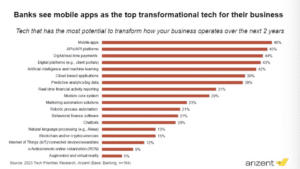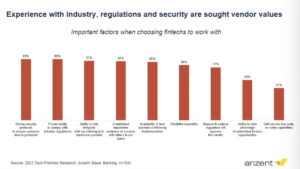Financial institutions need to continue investing in technology if they hope to remain relevant in today’s competitive market. However, establishing business priorities and knowing where to invest can be challenging. There is a lot to consider, such as limited data and resources, external factors in the market, and resistance to change from employees and stakeholders. Throw in the outdated legacy systems many financial institutions are dealing with and you’ve got another stack of challenges to factor in.
A recent study for business leaders on banking agility surveyed 164 employees from various banking institutions with knowledge of or involvement in their organization’s tech investments. Respondents were asked questions about their top business priorities, transformative technology, and the role of fintech companies in future innovation. Arizent’s Senior Industry Analyst, Michael Moeser, and FintechOS’s VP of Product Marketing, Mike Hughes, sat down to discuss the results. Here’s what they had to say.
Aligning Tech Spend and Business Strategy
The survey asked respondents what their top strategic business priorities were for the next two years. Their top five priorities in-order were as follows:
- Enhancing cybersecurity and data protection
- Maintaining regulatory compliance
- Improving data-driven decision-making
- Fostering customer experience innovation
- Improving the functionality of existing products
Unsurprisingly, cybersecurity emerged on top. Financial institutions hold countless amounts of sensitive information about their customers, costing an institution around $200 per account if a breach occurs, as well as putting their reputation on the line. The increase in cybersecurity threats since 2020 has also driven up the number of regulations in place for financial institutions, making change inevitable in order to avoid fines and lawsuits.
Improving data-driven decision-making, fostering customer experience innovation, and improving the functionality of existing products (such as faster payment methods) ranking next speak to the fact that banks know they need to innovate. Customers are bombarded with information and opportunities on a daily basis, and banks need to increase the quality of their products to keep up with customer expectations.
No matter where each business priority ranks for your financial institution, all of them are important. And to juggle them all, your business needs to become more agile. Unfortunately, it’s not that simple.
Reshuffling Tech Priorities and Investments
Banks are struggling to align their tech resources with their business priorities. According to the survey, conducted in December 2022, 61% of banks expected to increase their tech spending in 2023 and 75% expected to reshuffle at least some of their tech priorities.
When asked about their technology project prioritization for 2023, enhanced security, fraud mitigation, and customer onboarding ranked top three. These priorities have proved themselves to be ongoing projects over the past few years and aren’t expected to go away anytime soon.
Yet, when asked which technologies have the most potential to transform how their business operates over the next two years, mobile apps were the clear winner, especially for credit unions. Mobile apps were followed by APIs/API platforms, digital/real-time payments, digital platforms, and AI and machine learning.

Modernizing core systems rank 9th among transformative technologies. While maintaining core systems are an essential part of most tech and business strategies, they’re not going to move the dial when it comes to innovation.
The Struggle is Real: Dealing with Legacy Technologies
The biggest reason banks are struggling to align tech resources with business priorities are existing legacy systems. The outdated technology is both fragile and complicated, and it takes a large part of a financial institution’s tech resources just to keep these systems running–let alone drive data-driven decisions or improve customer experiences.
Many of the customers Hughes speaks to want to better leverage data to customize the products and services they are offering to customers at the time and place it makes most sense. They are also looking to innovate to better communicate with younger generations and take advantage of modern technology like face recognition, but don’t have the skillset to do it themselves.
That’s where bank-fintech partnerships come in.
Modernize and Innovate: Partner with a Fintech
Most banks now recognize that vendors such as fintech companies are bringing new ideas to the market, and in-turn streamlining innovation and digital transformations.
When asked what factors are most important to consider before choosing a fintech company to partner with, survey respondents sought strong security protocols to protect customer data, proven ability to comply with industry regulations, and the ability to integrate with their existing tech stack/core provider the most.

Finding a tech provider that can work with existing core systems is necessary for businesses who want to innovate and modernize simultaneously. One emerging solution can do just that.
Fintech enablement platforms can help technology investments move forward, allowing banks to define products, utilize analytics and data, and act like a fintech, without replacing existing core systems. They allow banks to build and deploy products and services quickly with no-code/low-code tools and have extensive customization capabilities without ever needing to start from scratch. With fintech enablement platforms, financial institutions can digitalize existing journeys and create new distribution channels with embedded finance.
Conclusion
Despite today’s economic challenges, financial institutions are choosing to invest in transformative technologies. Increasing revenue, reducing operational costs, and tapping into new markets are all made possible by investing in the proper technology partnerships.
Fintech enablement platforms can help move tech investments forward for banks struggling with banking agility because of outdated legacy systems. With the rise of digitally native banks and tech giants like Apple offering similar financial solutions in a streamlined manner, it’s more important than ever for traditional banks to innovate and capture new customers if they hope to compete in today’s shifting market.
Want to learn more about aligning tech spending with your business strategy? Watch the full webinar on-demand.



